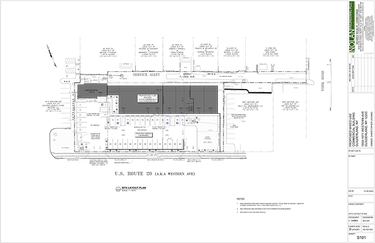Planning board issues negative report for mixed-use building on Route 20
— From Laviano submittal to the town of Guilderland
The owner of Laviano Wine & Liquor on Western Avenue is looking to construct an 8,500-square-foot mixed-use building on property he owns adjacent to his shop, but the Guilderland Planning Board says changes should be made before that process can begin.
GUILDERLAND — The Guilderland Planning Board recently recommended to the town’s zoning board of appeals that major changes be made to a proposed mixed-use building on Western Avenue before it considers approving the project.
However, the planning board’s report to the zoning board is only a recommendation; the zoning board can choose to ignore the recommendations.
Christopher Laviano is proposing an 8,500-square-foot structure be built next to his Laviano Wine & Liquor at 1871 Western Ave. The building would have 4,000 square feet on the first floor for two offices and one retail tenant, while the second floor would contain four residential apartments.
But the planning board in its report to the zoning board said the site plan should be modified “to conform more closely to the Town Zoning Code’s Site Plan Design Guidelines … and Town Comprehensive Plan (Westmere Corridor Study, 2016) and avoid the need for variances.”
At last month’s planning board meeting, when Laviano presented members with a proposal different from the one they’d seen in November, Chairman Stephen Feeney had said in response to the changes, “My biggest concern, Mr. Laviano, is that the building is kind of big for the site.”
Laviano’s changes included detaching the proposed mixed-use building from the existing on-site liquor store and decreasing the number of allowable office tenants from five to two.
Feeney’s concerns were incorporated into the board’s recommendation.
“The Planning Board does not see that the desire of the applicant to maximize the size of the building and push the limits of what the site can physically accommodate outweighs the adopted plans and codes of the Town,” the memo states.
The report says different building sizes, configurations, and uses should be considered.
“It seems that compliance with the design guidelines and zoning code were only given consideration after the Planning Board identified them and not prior to the applicant establishing the size, location, and design of the proposed building on the site and generating the self-created hardship,” the report states.
The report also notes the “footprint of the building appears to be too large for the site, thus triggering the need for setback and parking variances and making compliance with the design guidelines and the Westmere Corridor Study difficult.”
At the planning board’s Feb. 22 meeting, Town Planner Kenneth Kovalchik said there had been changes to Laviano’s four variance requests for his proposed development, which stretches across four small parcels between 1859 and 1871 Western Ave.
Laviano is seeking:
— Two variances to allow for parking in the site’s front and rear setbacks;
— A variance for setback requirements of differently-zoned districts; and
— A fourth variance for the minimum area required for buffers — “trees, hedges, shrubs and/or other landscaping,” according to Kovalchik — between residential and business districts.
The report also says, “The proposed building location also disregards the buffer requirements between the LB (Local Business) and BNRP (Business Non-Retail Professional) zones and the neighboring Residential zone ….”
The project was presented to the planning board with a future lot-line amendment already incorporated into the calculation of the buffer needed between differently-zoned districts: Two of the project parcels are located in the town’s Local Business District, for which town code requires a 40-foot buffer between it and a residential district, while the other parcels are part of a Business Non-Retail Professional District, for which code requires a 20-foot buffer between it and residential zones.
At last month’s meeting, Kovalchik explained that Jacqueline Coons, the town’s chief building and zoning officer, interpreted the code in a way that incorporated a proposed lot-line adjustment for the currently-zoned R15 service alley running behind 1855 to 1869 Western Ave. as part of the future development.
“So this is: Once the new lot-line amendment is approved, this will be the new lot line,” Kovalchik said on Feb. 22. “It won’t be to the service-alley lot line, it’ll be to the northern prospect line.”
Under the current site plan, the new building would be about five feet from the boundary line with the service alley; however, with the lot-line amendment being proposed, the service alley would become part of the proposed development, adding another 20 feet of buffer between the proposed building and the Kent Road residential neighborhood.
Albany Country Club
The planning board on March 8 approved the sketch plan for Albany Country Club, with members unanimously approving Kovalchik’s memo and its dozen recommendations to the town board.
The club is seeking to build 254 units:
— 88 single-family homes located on about 27 acres;
— 116 townhomes on about 23 acres; and
— 50 condominiums on about 4 acres.
Albany Country Club wants to rezone around half of its more than 800 acres from rural agricultural and residential to that of a Country Hamlet District. The town’s Country Hamlet zoning requirements include a minimum of 160 acres to be included in any development proposal of which 60 percent must be preserved as open space.
Among the recommendations highlighted by the board were:
— Additional land be conveyed to the town;
— That the proposed density be considered the maximum allowed density;
— The inclusion of a project phasing plan identifying both “unit build out and for completion milestones of proposed linkages to public infrastructure,” according to the report itself; and
— Additional traffic analysis for intersections at Wormer and Grant Hill and Wormer and Relyea roads.
The Country Hamlet review process follows the town’s Planned Unit Development review process, meaning the town board is the lead agency.
Medical office
Also on March 8, the planning board issued a negative State Environmental Quality Review declaration for a proposed medical building on the corner of Western Avenue and Hague Drive.
The declaration means the board determined the project’s construction would not have a significant adverse impact on the environment.
The hope was to have the public hearing on March 22, but because of issues related to notification, that might not be the case. And, if not, the hearing would take place at the board’s second meeting in April; the first April meeting having been canceled due to a holiday.
The zoning board in October 2017 approved a special permit for a 23,250-square-foot building, with 11,625 square feet of living space in the form of 11 apartments and 8,720 square feet for commercial endeavors on the corner of Western Avenue and Hague Drive. That building would have had 44 parking spaces.
The project has now been scaled down to an 8,000-square-foot medical-office building, and from two stories to one; the project requires 56 parking spots, but the applicant is proposing to install 35 spots with 21 banked, or potential future, spaces. A 2009 proposal similarly proposed a medical building on the site.
Whereas the zoning board was the original lead agency for the project, this time around it’s the planning board because the proposal needs only site-plan approval.


